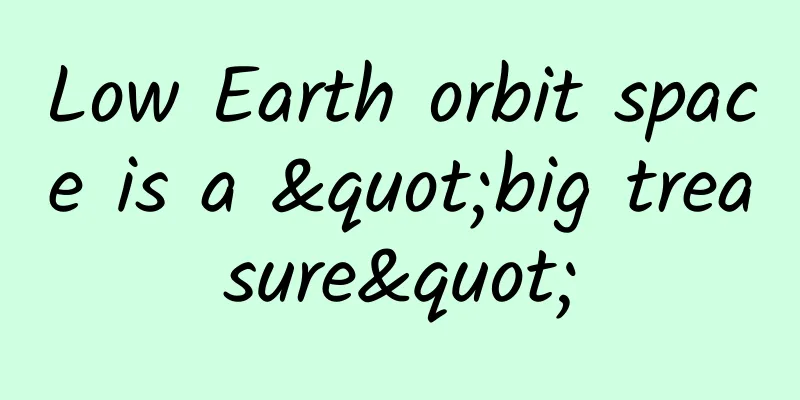Low Earth orbit space is a "big treasure"

|
Not long ago, after the successful launch of the Shenzhou XIV manned spacecraft, three astronauts will carry out the docking work between the Tianhe core module and the two major experimental modules "Mengtian" and "Wentian" in orbit, completing the comprehensive construction mission of China's Tiangong space station. This not only means that the Chinese have a stable "home" in space, but also means that our development of space resources, especially near-Earth orbit resources, has entered a new stage. So what are the space resources? Low Earth orbit is the space resource that has been most intensively developed and gained the most by humans. Precious resources, great utilization The history of human civilization is the history of exploration and development of resources. From the Stone Age, Bronze Age, Iron Age, Steam Age to the Information Age, human beings' ability to utilize the earth's resources has been rapidly expanding. In the past, all the resources that human development relied on were limited and confined to the small rocky planet Earth. In the current space age, the resources facing humanity are limitless. For example, there are at least a trillion stars like our sun in the universe, and even one billionth of the radiation energy of our tiny sun is enough to create all known life on Earth. The sun gave birth to life on Earth However, it is still a distant dream to develop the distant interstellar space with the existing human space technology. Humans can only start from the first step in front of them, especially the low-Earth orbit space 200-2000 kilometers away from the earth. This is the boundary between the earth and the vast space. It has the characteristics of space and is relatively easy to develop. Therefore, it has become the preferred orbit for manned space flight and most spacecraft. Once in low-Earth orbit, only a very small amount of propellant is needed to maintain a stable orbit around the Earth, and the spacecraft is also in a stable state of weightlessness. This is a perfect experimental environment that is almost impossible to maintain for a long time on Earth. For example, water droplets can easily form perfect spheres naturally in space, biological growth and movement are not affected by gravity, and the surface of the spacecraft can become a platform for high-tech experiments even in the special space radiation environment. In space, the impact of the Earth's atmosphere, magnetic field and ionosphere on spacecraft is much lower than on the Earth's surface. For example, when a space telescope enters space, it can observe electromagnetic waves in almost all bands. On Earth, most electromagnetic bands are inaccessible due to the shielding of the Earth's magnetic field/ionosphere, interference from meteorological conditions, and human light/electromagnetic pollution. Telescopes deployed in space have almost reshaped human astronomy In the space age, the brilliant space telescopes such as Hubble, Spitz and Herschel have almost reshaped human astronomy. In addition, the low-Earth orbit is closer to the Earth, has a faster orbital speed, and a shorter orbital period. Deploying remote sensing satellites in the low-Earth orbit can not only obtain clearer observation information, but also visit the world faster. After networking, it can also become a perfect "Skynet", which is of great significance. Therefore, if the Earth is the cradle of mankind, then low-Earth orbit is mankind’s first “baby walker”. Rich and diverse variety Low Earth orbit is the best choice for manned spaceflight. If the orbit is too low, the thin air will slowly lower the orbit of the spacecraft and space station, resulting in excessively high costs for maintaining a stable orbit for the space station, requiring frequent operation of the propulsion system carried by the spacecraft or the use of high-frequency cargo spacecraft to push the orbit up. If the orbit is too high, the Earth's ionosphere and magnetic field will provide less protection, making it vulnerable to the threat of abnormal cosmic radiation, and significantly increasing the difficulty of resupply. Low Earth orbit gives satellites ample space Manned spacecraft usually choose to operate on an orbit with an inclination of 40-50 degrees, which also has many advantages. This can not only ensure coverage of densely populated areas in the middle and low latitudes of the earth, but also make it easy to achieve measurement and control support; it can better utilize the inertia of the earth's rotation and improve launch efficiency. For example, after China entered the space station era, in addition to the traditional Jiuquan Satellite Launch Center, which continued to be used for manned launches due to its supporting facilities, subsequent space station construction and cargo spacecraft missions chose the Wenchang Space Launch Center with a lower latitude. Sun-synchronous orbits are another valuable space resource. The Earth is not a perfect sphere, and the flattening of this ellipsoid causes the inclination of the satellite orbit to change slowly. If the orbit is designed so that the inclination itself is affected by the Earth's gravity and is consistent with the Earth's natural precession around the Sun, then the local time when the spacecraft passes by a certain place on the Earth will be basically fixed. For example, every time the spacecraft passes through a certain point on the equator, it is 2 o'clock in the afternoon local time. Therefore, this orbit is called a sun-synchronous orbit, with an altitude of 600-800 kilometers and an orbital inclination of about 98 degrees. When a spacecraft flies over a place in a sun-synchronous orbit, it always has a stable lighting environment, which is of great significance to satellites such as optical remote sensing, meteorological detection and resource exploration, and can stably and repeatedly visit to obtain the most valuable information. If the orbit is designed more finely, so that the spacecraft always moves along the earth's twilight line, it can realize radar interferometry and other very energy-consuming earth observations, and can also be used for long-term and stable solar observations. The above two dominant orbits have absolute advantages in the development of low-Earth orbit resources. In addition, there are some special applications based on this orbit. For example, polar orbits will stably pass over the two poles, and under the effect of the earth's rotation, they can achieve full coverage of the earth. Orbits with low inclinations such as those over the equator can cover the most densely populated areas on the earth and have higher commercial value. Development shows acceleration The low-Earth orbit has always been the space resource that has been most intensively developed and gained the most by humans. Whether it is the major manned space projects of mankind, such as the Salyut series, Mir, Skylab, the Space Shuttle, the International Space Station and the Tiangong Space Station, or various satellites for meteorology, remote sensing, geoscience and astronomy, the low-Earth orbit is the preferred destination. However, with the large-scale launch of low-orbit Internet communication satellites, the low-Earth space has become increasingly crowded. Take the Starlink satellite constellation being built by SpaceX in the United States as an example. With the technical and cost advantages of the reusable Falcon 9 rocket, Starlink satellites are rapidly occupying the orbital resources of near-Earth space. If we also consider the huge low-orbit satellite constellations launched by OneWeb, Amazon, Airbus, Samsung and other companies, it means that in the low-orbit range alone, the world will launch tens of thousands of satellites in the next 10-20 years, far exceeding the satellite accumulation in the previous 60 years, and this is only one field of satellite Internet. On the surface, the resources in low-Earth orbit are almost infinite, and it is still "extremely empty" compared to the existing number of human spacecraft. But space is also full of risks. Every spacecraft in low-Earth orbit is moving at a speed of more than 7 kilometers per second, which is almost 200 times the speed limit of 120 kilometers per hour on highways. In this case, the kinetic energy of any object is extremely large and the destructive power is amazing. Therefore, there may be many accidental risks for spacecraft in operation. Once a collision occurs between spacecraft or with space debris, the amount of space debris will increase suddenly. If it is not controlled and space debris is allowed to grow at will, in the foreseeable future, the earth will be covered with space debris. Therefore, humans must find a way to keep the near-Earth orbit environment clean. A large amount of space debris and active spacecraft are crowded together, which can easily cause collisions The best solution is to address the root cause. On the one hand, we should prevent satellites from becoming space junk from the very beginning. When designing satellites and rockets, we should leave a certain margin so that they can carry enough propellant. When the satellites are nearing the end of their life span, they can use their last bit of power to leave orbit and return to the atmosphere to burn up. On the other hand, all countries in the world should formulate unified space traffic rules to prevent potential collision risks and jointly develop space resources peacefully. |
<<: If the universe is a "dark forest", why do we go to so much trouble to look for aliens?
>>: What are the dangers of ethylene glycol explosion?
Recommend
Uncovering the gems of our table: the nutritious and versatile legume family
Legumes such as soybeans, mung beans, broad beans...
A chicken that grew 5 kilograms in 42 days, was it injected with hormones?
A chicken over a month old was killed innocently?...
8.15 Japan surrenders! A comprehensive review of the Anti-Japanese War
The above content is excerpted from: "Comic ...
Lao Na's Gravity Cube System Course allows you to master low PPC and high ROI gameplay, worth 299 yuan
Lao Na's Gravitational Cube System Course all...
Apple CEO Cook rarely reveals his smart home private life throughout the day
Tencent Technology News: Smart home and the Inter...
4 steps to product advertising conversion: analysis of search advertising conversion
The ultimate goal of search advertising is to bri...
Don’t say “pink and tender”, it is the real version of “beautiful scenery in the desert”
There are countless magical and beautiful plants ...
Wei Buhuo: A short video editing course that novices can learn in one go, solving common problems you encounter in daily editing
Wei Buhuo: A short video editing course that even ...
General tips for excellent Weibo advertising | There is always one optimization of these 26 details that can reduce costs!
Three principles of image matching 1. Prioritize ...
Corn's origins have been updated: It turns out it has two "ancestors"
The food crops we eat all have their wild origins...
Let's have a barbecue on May Day. Let's take a look at some interesting facts about barbecue.
As the weather warms up The barbecue industry is ...
The best development environment and efficient API building method
These days, just about every developer is familia...
Where can I get the Wenchang Pagoda? Where is Wenchang Tower effective?
Now, there are enough Feng Shui mascots on the ma...
Drinking coffee before shopping could cost you half the money
In the past, I often heard people say, "It&#...
Why did sugarcane "conquer" the world?
Sugarcane attraction conquers the world Apart fro...









